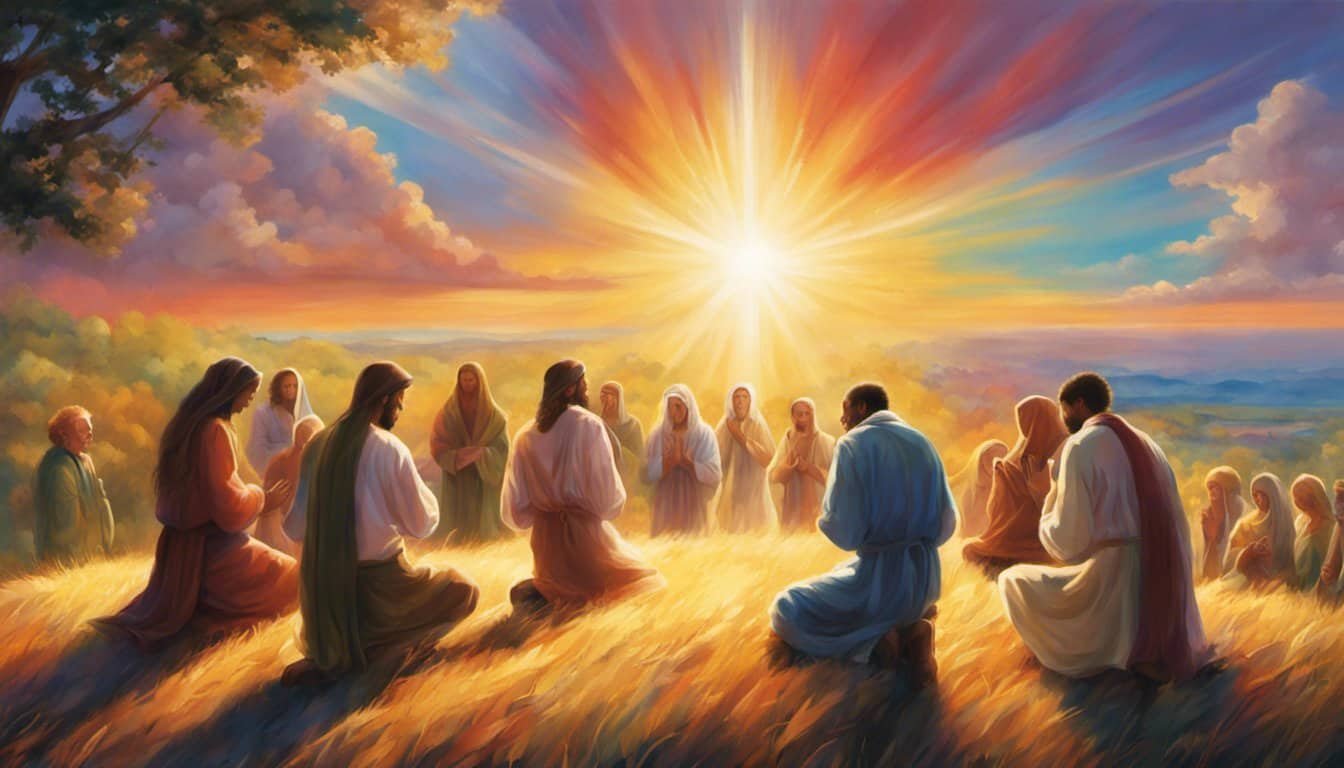The Apostle John opens his second letter with a warm greeting to “the elect lady and her children.”
This phrase has sparked centuries of discussion.
Many scholars believe the elect lady was either a respected Christian woman or a local congregation John cared for deeply.
Both views shape how people understand the letter’s message today.


John addresses her directly and offers guidance about truth, love, and guarding against false teaching.
The letter’s personal tone suggests a close relationship, whether with an individual host of a house church or a symbolic community of believers.

His words carry a sense of pastoral care and urgency.
Exploring who the elect lady was gives insight into early Christian life, leadership, and fellowship.
Understanding her identity also helps explain the letter’s themes and its place alongside John’s other writings.
The Identity of the Elect Lady
In 2 John 1:1, the Apostle John greets “the elect lady and her children.”
This phrase has led to different interpretations about whether she was a real person, a symbolic figure, or someone known in early church history.
Literal Interpretation: A Christian Woman
Many Bible scholars believe the elect lady was an actual Christian woman.
John’s mention of “her children” in verses 1 and 13 suggests he may have spoken to a family he knew personally.
The Greek phrase ἐκλεκτῇ κυρίᾳ (eklektē kyria) can mean “chosen lady” or “elect lady.”
Kyria was a common female name in the first century, so it may have been her given name.
If she was a real person, she may have led or hosted a house church in Asia Minor.
This fits with the early church practice of meeting in homes led by faithful believers.
John’s letter gives encouragement and warnings, showing he trusted her spiritual maturity and influence.
Symbolic Interpretation: The Church
Another view is that the elect lady represents a local congregation rather than an individual.
In this reading, her “children” would be the church members.
Some suggest John used symbolic language to protect believers during persecution.
By writing to “the chosen lady,” he could address the church without naming it directly.

The Bible sometimes uses feminine imagery for God’s people.
For example, the church is called the “bride of Christ” in other New Testament passages.
Supporters of this view point out the letter’s focus on truth, love, and guarding against false teachers.
These instructions apply to a whole church, not just one household.
Alternative Theories: Mary, Martha, or Kyria
A smaller group of interpreters have proposed specific identities.
Some suggest the elect lady could have been Mary of Bethany or Martha, known from the Gospels.
Others note that Kyria could be a proper name, meaning the letter was addressed to a woman named Kyria.
This would make “elect” an adjective describing her as chosen by God.
These theories are less widely accepted because the letter does not give enough details to confirm them.
However, they remain part of the discussion about early church figures and John’s personal relationships.
Debate Among Bible Scholars
The identity of the elect lady remains uncertain.
As Bible Hub notes, there are strong arguments for both literal and metaphorical readings.
Linguistic studies of the Greek text ἐκλεκτῇ κυρίᾳ show that it can be read as a name or a title.
Early church writings also give no clear consensus.
Some scholars focus on the historical context of 2 John, while others emphasize the theological themes.
The lack of definitive evidence allows for multiple interpretations.
John’s Purpose in Addressing the Elect Lady

John wrote his second epistle to strengthen the recipient’s faith and protect her community from harmful influences.
He focused on living out Christ’s teaching while guarding against those who distort it.
Encouragement in Truth and Love

John began by affirming the elect lady and her children for walking in truth.
This phrase means living in agreement with the teaching of Christ and the apostles.
He reminded them that truth and love work together in Christian life.
He urged them to love one another as a commandment they had received from the beginning.
This love was not based on feelings but on obedience to God’s word.
John wanted them to keep their relationships rooted in truth so their love would not drift into compromise.
By combining truth and love, the community could remain united and strong.
This balance would help them resist confusion and keep doctrinal purity.
Warning Against Deceivers and False Teachers
John gave a clear warning about deceivers who denied the doctrine of Christ.
These individuals claimed to follow God but rejected the truth that Jesus came in the flesh.

He cautioned that such false teachers could lead believers away from the gospel.
The risk was not only losing clarity but also forfeiting the spiritual rewards of faithful service.
John instructed them not to welcome or support anyone spreading false teaching.
This was about protecting the church from error.
By refusing to give a platform to those who distort the truth, the elect lady and her community could continue walking in truth without compromise.
This safeguard preserved their faith and ensured their fellowship remained grounded in Christ’s teaching.
For more on the possibility that the elect lady was a respected Christian woman or a congregation, see Bible Hub’s explanation.
Key Themes in the Second Epistle of John


The Second Epistle of John focuses on living out the truth of the gospel in daily life.
It urges believers to remain faithful to Christ’s teachings, practice genuine love within the Christian community, and guard the church from harmful influences.
Truth and Obedience
John links truth with obedience, showing that knowing the truth is not enough—believers must act on it.
He reminds the Christian church that following Christ’s commands proves genuine faith.
Obedience means staying aligned with the message handed down from Christ and the apostles.
This includes rejecting false ideas about Jesus and holding firmly to the gospel.
He warns that those who do not remain in Christ’s teaching should not be welcomed as spiritual teachers.
This protects the church from drifting away from the truth.
Key reminders:
- Truth is lived, not just believed.
- Obedience confirms faith.
- Remaining in Christ’s teaching keeps believers united.
Christian Love and Hospitality

John encourages believers to show love by caring for one another in the Christian community.
This love is active, expressed through support, kindness, and meeting each other’s needs.
Hospitality was vital in the early church, especially for traveling teachers and missionaries.
Welcoming fellow believers into one’s home helped the gospel spread.
John also cautions against offering hospitality to those who reject Christ’s teaching.
In doing so, the church avoids supporting harmful messages.
Hospitality guidelines in 2 John:
| Show hospitality to | Withhold hospitality from |
|---|---|
| Faithful believers | False teachers |
| Traveling missionaries | Those denying Christ’s teaching |
Discernment and Doctrinal Purity
Discernment is the ability to tell truth from error.
John urges the church to test the message of anyone who claims to teach in Christ’s name.

Doctrinal purity means keeping the teaching about Jesus unchanged.
This protects the Christian church from confusion and division.
False teachers often claimed spiritual authority but denied key truths about Jesus.
By refusing to endorse them, believers kept the message of the gospel clear and trustworthy.
Maintaining both love and truth allowed the early Christian community to grow strong while staying faithful to Christ’s commands.
For more on the historical context and possible identity of the “elect lady,” see Who is the elect lady in 2 John?
Historical and Cultural Context

In the late first century, Christian communities were small and often met in homes led by trusted believers.
The New Testament letters often addressed specific people or groups, reflecting the close-knit nature of the early church.
These gatherings faced internal challenges from false teaching and external pressures from surrounding cultures.
Role of Women in the Early Church
Women played a visible role in the early church, even within the patriarchal norms of the Roman world.
Some hosted gatherings, taught new believers, or supported traveling ministers.
In the New Testament, figures like Priscilla, Phoebe, and Lydia appear as co-workers in ministry.
Hosting a house church often meant managing hospitality, teaching, and community care.
The reference to an “elect lady” in 2 John may reflect such a role.
Whether she was a specific woman or a symbolic figure, the greeting shows respect and recognition of her leadership.

This indicates that women could hold positions of influence in their local church settings, despite cultural limits on public authority.
House Churches and Local Congregations
In the first century, believers did not meet in dedicated church buildings.
They gathered in private homes, forming what we now call house churches.
A home large enough to host a congregation often belonged to someone with resources and social standing.
That person—man or woman—would naturally become a leader in the group.
Meetings included reading New Testament letters, prayer, singing, and teaching.
Leaders also guarded the group’s beliefs against false teachers, which was a major concern in 2 John.
The personal tone of the letter fits the intimate setting of a small congregation meeting in a home.
Asia Minor and the Spread of Christianity

Many scholars believe 2 John was written to a community in Asia Minor, a region that includes modern-day Turkey.
This area was a hub for travel and trade, which helped spread the Christian message.
Cities like Ephesus, Smyrna, and Pergamum were home to active congregations.
The Apostle John is traditionally linked to Ephesus, making it a likely base for his ministry.
The spread of Christianity here was not without challenges.
Competing philosophies, pagan religions, and early forms of Gnosticism threatened the unity and beliefs of the early church.
Letters like 2 John addressed these issues directly and guided believers in faith and practice.
Connections to Other Johannine Letters

The letter of 2 John shares themes and language with other writings attributed to the Apostle John. It addresses truth, love, and the need to guard against false teaching.
John uses similar expressions and tone in his other letters. These overlaps help readers see how the “elect lady” fits into the broader Johannine context.
Comparisons with 1 John
1 John focuses on the link between love and obedience to God’s commands. Similarly, 2 John urges the elect lady and her children to “walk in truth” and “love one another.”
Both letters warn against deceivers who deny that Jesus came in the flesh. This concern shows that both audiences faced similar theological challenges.
The style is alike in both letters. John uses short, direct statements and repeats key phrases for emphasis.
For example, “walk in truth” appears in both letters as a sign of genuine faith. A key difference is scope.
1 John addresses a wider Christian community. 2 John is written to a single recipient, either a woman or a congregation.
This personal tone makes 2 John feel more like a pastoral note than a general sermon.
Relationship to 3 John and Gaius
3 John is addressed to Gaius, a believer praised for showing hospitality to traveling teachers. This focus on welcoming faithful workers connects with 2 John’s warning not to receive false teachers.
Both letters discuss how Christians should respond to those who claim to teach the truth. In 3 John, John encourages Gaius to support those who serve Christ faithfully.
In 2 John, John tells the elect lady to avoid giving aid to those spreading error. The tone in both is warm and personal.
John commends Gaius for his faithfulness. He also commends the elect lady’s children for walking in truth.
This shows a consistent pastoral approach that values encouragement alongside correction.
The Lasting Significance of the Elect Lady
The figure known as the “elect lady” shows how early believers understood being chosen by God and living out faith in daily life. Her mention also reflects the important role women and communities played in preserving truth and resisting false teaching.
Chosen by God: Theological Implications
The term elect means “chosen.” In 2 John, this title points to a spiritual selection by God, based on faith in Jesus Christ.
Being called “elect” placed the lady in the same group as all believers who trust in Christ. This status brought both privilege and responsibility.
Belonging to God’s family was a privilege. Guarding the truth was a responsibility.
The letter’s greeting shows that election is not abstract. It is personal and relational.
The elder writes warmly, affirming that God’s choice is active in her life and in the lives of her children. In the early church, such language reminded believers that their identity came from God’s call, not from cultural approval.
This helped them remain faithful even when facing opposition or false doctrine.
Impact on Christian Community and Doctrine
Whether the elect lady was an individual or a symbol for a local church, her example shows the role of the Christian community in protecting sound teaching.
The warnings in 2 John against false teachers show that truth was a shared responsibility. Leaders, families, and congregations worked together to keep the message of Jesus Christ pure.
The letter addresses her directly, which highlights women’s active roles in the early church. They hosted gatherings, taught younger believers, and influenced community life.












